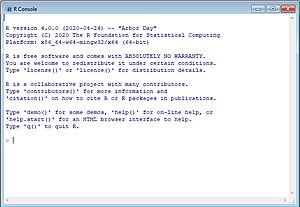- Using Python with RStudio. You can use Python with RStudio professional products to develop and publish interactive applications with Shiny, Dash, Streamlit, or Bokeh; reports with R Markdown or Jupyter Notebooks; and REST APIs with Plumber or Flask. For an overview of how RStudio helps support Data Science teams using R & Python together, see.
- Basic Data Analysis through R/R Studio. In this tutorial, I 'll design a basic data analysis program in R using R Studio by utilizing the features of R Studio to create some visual representation of that data. Following steps will be performed to achieve our goal. Downloading/importing data in R. Transforming Data / Running queries on data.
- RStudio Cloud is a lightweight, cloud-based solution that allows anyone to do, share, teach and learn data science online. Analyze your data using the RStudio IDE, directly from your browser. Share projects with your team, class, workshop or the world. Teach data science with R to your students or colleagues.
No matter how much you know about the R ecosystem already, you’ll always have more to learn. At RStudio, we know that everyone is at a different stage in learning the vast ecosystem of R, ranging from rank beginner to seasoned data scientists to professional educators. Choose a starting point below, or catch up with us on our blog. Many useful R function come in packages, free libraries of code written by R's active user community. To install an R package, open an R session and type at the command line. Install.packages('s name') R will download the package from CRAN, so you'll need to be connected to the internet.
You can use Python with RStudio professional products to develop and publish interactive applications with Shiny, Dash, Streamlit, or Bokeh; reports with R Markdown or Jupyter Notebooks; and REST APIs with Plumber or Flask.
For an overview of how RStudio helps support Data Science teams using R & Python together, see R & Python: A Love Story.
For more information on administrator workflows for configuring RStudio with Python and Jupyter, refer to the resources on configuring Python with RStudio.
Developing with Python#
Data scientists and analysts can:
- Work with the RStudio IDE, Jupyter Notebook, JupyterLab, or VS Code editors from RStudio Workbench
Want to learn more about RStudio Workbench and Python?#
For more information on integrating RStudio Workbench with Python, refer to the resources on configuring Python with RStudio.
Publishing Python Content#
Data scientists and analysts can publish Python content to RStudio Connect by:
R Studio Summary Statistics


- Publishing Jupyter Notebooks that can be scheduled and emailed as reports
- Publishing Flask applications and APIs
- Publishing Dash applications
- Publishing Streamlit applications
- Publishing Bokeh applications
Ready to publish Jupyter Notebooks to RStudio Connect?#
View the user documentation for publishing Jupyter Notebooks to RStudio Connect
Ready to share interactive Python content on RStudio Connect?#
Learn more about publishing dash or flask applications and APIs.
View example code as well as samples in the user guide.
Publishing Python and R Content#
Data scientists and analysts can publish mixed Python and R content to RStudio Connect by publishing:

- Shiny applications that call Python scripts
- R Markdown reports that call Python scripts
- Plumber APIs that call Python scripts
Mixed content relies on the reticulate package, which you can read more about on the project's website.
View the user documentation for publishing content that uses Python and R to RStudio Connect
Cheat sheet for using Python with R and reticulate
Managing Python Packages#
RStudio Package Manager supports both R and Python packages. Visit this guide to learn more about how you can securely mirror PyPI.
Additional Resources#
Want to learn more about RStudio Connect and Python?#
Frequently asked questions for using Python with RStudio Connect
Learn about best practices for using Python with RStudio Connect
Want to see examples of using Python with RStudio?#
View code examples on GitHub of Using Python with RStudio
Rstudio Software
View examples of Flask APIs published to RStudio Connect
Introduction
Leaflet is one of the most popular open-source JavaScript libraries for interactive maps. It’s used by websites ranging from The New York Times and The Washington Post to GitHub and Flickr, as well as GIS specialists like OpenStreetMap, Mapbox, and CartoDB.
R Studio Seq
This R package makes it easy to integrate and control Leaflet maps in R.
R Studio Ssl
Features
- Interactive panning/zooming
- Compose maps using arbitrary combinations of:
- Map tiles
- Markers
- Polygons
- Lines
- Popups
- GeoJSON
- Create maps right from the R console or RStudio
- Embed maps in knitr/R Markdown documents and Shiny apps
- Easily render spatial objects from the
sporsfpackages, or data frames with latitude/longitude columns - Use map bounds and mouse events to drive Shiny logic
- Display maps in non spherical mercator projections
- Augment map features using chosen plugins from leaflet plugins repository
Installation
To install this R package, run this command at your R prompt:

Once installed, you can use this package at the R console, within R Markdown documents, and within Shiny applications.
Basic Usage
R Studio Software
You create a Leaflet map with these basic steps:
- Create a map widget by calling
leaflet(). - Add layers (i.e., features) to the map by using layer functions (e.g.
addTiles,addMarkers,addPolygons) to modify the map widget. - Repeat step 2 as desired.
- Print the map widget to display it.
Here’s a basic example:
In case you’re not familiar with the magrittr pipe operator (%>%), here is the equivalent without using pipes:
Next Steps

We highly recommend that you proceed to The Map Widget page before exploring the rest of this site, as it describes common idioms we’ll use throughout the examples on the other pages.
Although we have tried to provide an R-like interface to Leaflet, you may want to check out the API documentation of Leaflet occasionally when the meanings of certain parameters are not clear to you.